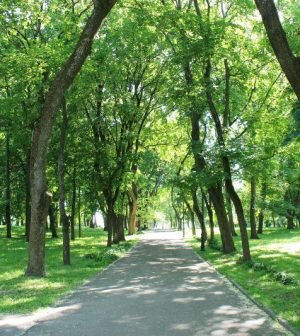- Navigating Your Midlife Crisis: Embracing New Possibilities
- City Raccoons Showing Signs of Domestication
- Mapping the Exposome: Science Broadens Focus to Environmental Disease Triggers
- One Week Less on Social Media Linked to Better Mental Health
- Your Brain Changes in Stages as You Age, Study Finds
- Some Suicide Victims Show No Typical Warning Signs, Study Finds
- ByHeart Formula Faces Lawsuits After Babies Sickened With Botulism
- Switch to Vegan Diet Could Cut Your Greenhouse Gas Emissions in Half
- Regular Bedtime Does Wonders for Blood Pressure
- Dining Alone Could Mean Worse Nutrition for Seniors
Living Near Green Spaces Could Strengthen Your Bones

Living close to trees and other greenery could be keeping your bones strong, a new 12-year study suggests.
Folks whose residences were near spots deemed “green” by satellite imagery tended to have better bone density than those who lived elsewhere, Chinese researchers found.
Reductions in air pollution seemed key to greenery’s benefit for bones, according to a team led by Zhengxiao Ouyang, of Central South University in Changsha.
“These findings provide valuable insights into the potential of greenness in preventing the onset of osteoporosis and emphasize the significance of urban greening in developing effective prevention strategies,” Ouyang’s team said.
The findings were published March 5 in the Annals of the Rheumatic Diseases.
The study drew on data from over 391,000 British people whose habits and health are being tracked by the UK Biobank database. Participants averaged 56 years of age, and 53% were women.
Besides recording data on each person’s bone mineral density and their genetic risk for osteoporosis, the Biobank also contained data on their diet, smoking status, income, exercise levels and other factors.
The Chinese team used satellite imagery to figure out how “green” the area around each person’s residence was. Separate data was used to track local levels of air pollution.
Over the 12 years included in the study, 9,307 people went on to develop a new case of osteoporosis.
The study wasn’t designed to prove cause-and-effect. However, for every 1,000 feet of residential green space available to a person, their odds of developing osteoporosis fell by 5%, Ouyang’s group reported.
Reduced air pollution appeared to be the mediating factor.
“People living in the leafiest areas will be exposed to a lower risk because the trees and plants act as natural filters, removing pollutants from the air,” according to a news release from the journal’s publishers.
Folks who were more physically active also had stronger bones, and green spaces might also encourage exercise, the researchers theorized.
“The findings from this study present the first evidence indicating that residential greenness is associated with higher bone density and decreased risk of developing osteoporosis,” Outang’s group concluded.
More information
Find out more about reducing your odds for osteoporosis at Johns Hopkins Medicine.
SOURCE: BMJ Press, news release, March 5, 2024
Source: HealthDay
Copyright © 2025 HealthDay. All rights reserved.










